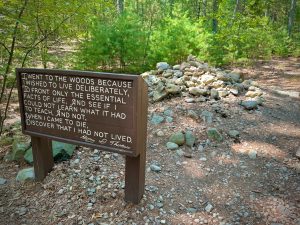Taking a Walk Along Walden Pond
CONCORD, MASSACHUSETTS — After five days of unseasonably warm weather, at last we have been rewarded on a brilliant Saturday with near-perfect temperatures in the 70s, just in time for a nice hike along Walden Pond, a few miles outside this quaint town of nearly 20,000. I was born 60 miles north in Concord, New Hampshire. This is my first visit to its Bay State counterpart, incorporated in 1775 and celebrating its 250th birthday this year. The Granite State Concord is a decade older and sports about twice as many residents. Neither town is exactly a metropolis.
Walden Pond gained its fame from Henry David Thoreau, who spent two years (1845-1847) living in a cabin on its northern shore. His friend and mentor, fellow writer Ralph Waldo Emerson, owned the land. At the time, the pond was neglected and abused; the town’s dump was across the road. Thoreau’s master work, Walden, or Life in the Woods, was published in 1854. One of his most famous quotations: Live in each season as it passes; breathe the air, drink the drink, taste the fruit, and resign yourself to the influences of each.
most famous quotations: Live in each season as it passes; breathe the air, drink the drink, taste the fruit, and resign yourself to the influences of each.
Hey, I’m trying.
Having never been here, I made assumptions about Walden Pond that proved wrong, as they usually do. First, it is far larger than expected, covering 64.5 acres. The Walden Pond Reservation, deeded to the state by Emerson’s descendants in 1922, totals 335 acres. East Texas native Don Henley, of the Eagles, was instrumental in preventing the area around the pond from being developed.
On this Saturday morning, the pond’s parking lot was nearly full. As it turns out, Walden Pond is a popular recreation area with a roped-off swimming area. People were swimming, sunning themselves on the sandy shore, casting fishing lines into the water, and paddling kayaks and canoes. Walden Pond was formed by retreating glaciers about 12,000 years ago, leaving what is considered a good example of a “kettle hole,” formed by the blocks of dead ice left behind. The pond is more than 100 feet deep at its maximum.
We trudged a narrow trail to the northern part of the pond, which is where Thoreau built his small cabin in second-growth forest along its shores. The cabin was sold and moved off the land right after Thoreau ended his experiment of living in the woods. An amateur archaeologist named Roland W. Robbins in 1945 used Walden or, Life in the Woods to figure out where the cabin had stood and started digging. He uncovered the foundation stones and chimney base of the original cabin, now marked by granite pillars about 3 feet high. A replica cabin and statue of Thoreau are now near the parking area.
Thoreau was a member of the transcendentalist movement and a lifelong abolitionist. He advocated civil disobedience, is considered a founder of the environmental movemen t in America, and refused to pay his taxes to avoid financing the Mexican-American War. (My kind of guy.)He advocated simple living and deep appreciation for nature. (Another of his famous sayings: Simplify, Simplify. One can buy a T-shirt inscribed with such in the gift shop, which seems counterintuitive.)
t in America, and refused to pay his taxes to avoid financing the Mexican-American War. (My kind of guy.)He advocated simple living and deep appreciation for nature. (Another of his famous sayings: Simplify, Simplify. One can buy a T-shirt inscribed with such in the gift shop, which seems counterintuitive.)
Thoreau died at the age of 44, suffering from tuberculosis for much of his life. He is buried with members of his immediate family at Sleepy Hollow Cemetery outside Concord. Among his gravestone neighbors are Ralph Waldo Emerson and family, and a sizable contingent of the Alcott family, including Louisa May Alcott, author of Little Women. Nathaniel Hawthorne (The Scarlett Letter), who was born in nearby Salem and died in Plymouth, New Hampshire, is also buried in Sleepy Hollow. Thoreau clearly is in good company below ground.
This is almost certainly apocryphal, to the best of my knowledge, but worth including. Thoreau was ill from the effects of tuberculosis and caught bronchitis while counting tree rings outside during a thunderstorm. On his deathbed, he was asked if he had made peace with God.
He purportedly replied: I did not know we had ever quarreled.
Leave a reply
Fields marked with * are required











